
Section 106 agreements / unilateral undertakings (‘S106s’) are often the last link in the chain before planning permission can be granted. Whilst applicants are always eager to complete such agreements it is important that any planning obligations contained within them are no more than is necessary to mitigate the planning harm caused by the proposed development.
Such obligations must be
a) necessary to make the development acceptable in planning terms
b) directly related to the development
c) fairly and reasonably related in scale and kind to the development.
Planning obligations can be either a requirement to do something (or not to do something) on the application site; examples include the provision of affordable housing, providing public open space or play parks; or financial obligations where payments are secured for infrastructure within the vicinity of the application site, such as educational facilities, community facilities, highway works etc. S106s also tend to require the owner of the land to pay the Local Planning Authority’s (‘LPA’) legal fees and a planning monitoring fee; a fee LPAs charge for monitoring compliance with the planning obligations contained within the S106.
How can the S106 process run smoothly?
In order to assist LPAs (that are often under resourced) Sarah-Jane Williams suggests the following:
- Engage with the LPA from the outset. Where the planning officer is seeking to recommend approval agree S106 heads of terms where possible and encourage the planning officer to instruct their legal team.
- The Council’s legal team will want their fees paid, so most solicitors will require these monies on account before the Council will start drafting.
- Anyone with a legal interest in the land to be bound by the S106 is likely to be required to be a party to the agreement. The S106 is registered as a Land Charge and runs with the land. It is therefore important that your red line location plans are correct and do not include any unexpected third-party land – or that you have discussed this point in detail with the Planning Officer in advance.
- Where the land is unregistered, you will need to demonstrate to the LPA who owns the land. Ensure you have an Epitome of Title to evidence ownership ready rather than dealing with it at the S106 stage.
- Where there is a lender who has an interest in the application site engage with them early to help speed up the process. Some lenders may wish for valuations to be undertaken or ask for their charge to be released from the application site. It is good to seek details of the banks position prior to sending the draft S106 for their approval.
Our Planning team negotiate and draft Section 106 agreements on a daily basis; it is a vital part of the planning process. If your planning proposal requires a S106, please feel free to get in touch with our Planning team.
